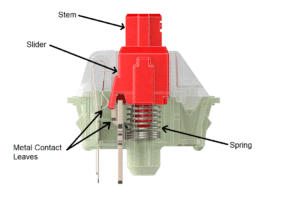This was our first assignment for the semester. I was actually considerably satisfied with this technical description, however, I did not really follow the formatting requirements, and I didn’t cite my sources properly. I should have focused more on planning and formatting instead of mostly the raw information, although that is also pretty important.
Cherry Mx Red Mechanical Keyboard switches
Mechanical Keyboards are keyboards that use individual physical switches underneath each key to register when a key has been pressed. There are different types of mechanical key switches in mechanical keyboards, that vary in the type of feedback received when a key is pressed. They all consist of a stem, switch housing, a slider, metal contact leaves, and spring. The leading brand of key switches would be Cherry MX switches. Cherry Mx Red switches are mechanical key switches that don’t provide any tactile feedback or any auditory click sound. Standard keyboards that you will find in most places, on the other hand, will most likely be membrane keyboards. These use a layer, or “membrane,” of flexible plastic under the keys. When a key is pressed, certain parts under the layer with conductive traces come into contact with a circuit underneath, and the computer registers that that key has been pressed.
In a Mechanical key switch, the keycap, which is the part that we press, is mounted onto the stem, which is usually colored to indicate the type of key switch it is. The switch housing is the casing that all the components are in. The slider pushes against the spring, located at its base, as well as interrupt the connection of the metal contact leaves, located at the side of the switch. There are three different types of key switches – Linear, tactile, and clicky. Clicky switches produce an auditory “click” sound as well as provide a bump felt in the middle of travel of the keystroke. Tactile switches only provide the bump as feedback for a button being pressed. Linear switches provide no voluntary feedback when pressed. These differences in feedback are due to differences in the shape of the part of the slider that interrupts the metal leaves.

Cherry MX Red switches are a type of linear mechanical key switch. They require very little force to operate – only 45cN (45g or 0.45N). The total travel distance that a Cherry MX red can be pressed is 4mm, but the actuation distance, which is the minimum distance the key must be pressed for it to be registered, is 2mm. This all means that they have a very smooth keypress with minimal resistance and can be triggered really fast. This is ideal for light and fast typists and people who play fast-paced games, although it is still up to personal preference.
When the keycap on the stem is pressed, the slider is pushed down against the spring, and the part of the slider that is interrupting the metal contact leaves moves down away from them. The metal leaves strike each other, and this sends a signal to the computer to register the keystroke. When the key is released, the spring pushes the slider back up, and the connection between the leaves is broken again.
- genclaymore, Membrane Keyboard vs mechanical Keyboard: Which One should You Use [Blog Post], Havit Online, https://www.prohavit.com/blog/membrane-keyboard-vs-mechanical-keyboard/
- The Computer Language Co Inc., membrane keyboard, https://www.pcmag.com/encyclopedia/term/membrane-keyboard
- Computer Lounge, (May 15 2019), Ultimate Keyboard Showdown: Mechanical vs. Membrane Keyboards [Blog Post], Computer Lounge, https://www.computerlounge.co.nz/blog/tips-and-tricks/ultimate-keyboard-showdown-mechanical-vs-membrane-keyboards
- Miller P., (Oct 17 2011), Mechanical Keyboard FAQ: Pick the right switch [Blog Post], PCWorld, https://www.pcworld.com/article/242037/mechanical-keyboard-faq-pick-the-right-switch.html
- Wong A., (April 06 2019), The complete guide to mechanical keyboard switches for gaming [Blog Post], PCGAMER, https://www.pcgamer.com/best-mechanical-switches-for-gaming/
- Cherry,https://www.cherrymx.de/en/mx-original/mx-red.html#techSpecs
- Cherry,https://www.cherrymx.de/_Resources/Persistent/b7ab2f72bd5686e1e1e759a9f3703536d7fb1e18/EN_CHERRY_MX_RED.pdf
- Sarfraz,(April 17 2020), Best mechanical switches for Gaming [Blog Post], Xtreme Gaminerd, https://www.xtremegaminerd.com/best-mechanical-switches-for-gaming/



